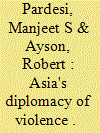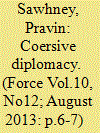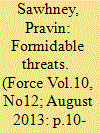| Srl | Item |
| 1 |
ID:
151610


|
|
|
|
|
| Summary/Abstract |
Military coercion has already changed the Asia-Pacific region.
|
|
|
|
|
|
|
|
|
|
|
|
|
|
|
|
| 2 |
ID:
126118


|
|
|
|
|
| Publication |
2013.
|
| Summary/Abstract |
In an unexpected development, a Chinese border guards' platoon (30 soldiers) moved in and pitched tents 19 kilometres inside Indian territory at Depsang Valley overlooking Daulet Beg Oldie (DBO) on 15 April 2013 in Ladakh in the Western sector. The last time they did a similar thing was in 1986 in Sumdorong Chu in the Eastern sector (Arunachal Pradesh). Both times, the Chinese forces had blessings from the highest quarters: then supremo Deng Xiaoping and now the President and chairman of the Central Military Commission, Xi Jinping. Then, the Chinese were not a risen power and the occupation of Sumdorong Chu, of little tactical significance, was meant to test Indian gumption, through military coercion, after the passing away of Prime Minister Indira Gandhi, who Deng admired for being a strong and determined leader. There was a year-long stand-off with menacing military build-up on both sides ending in a mutually agreed disengagement with neither side looking a loser. The Chinese finally left Sumdorong Chu of own free accord in 1995. China's military coercion had not worked for two reasons: India showed political will, and China's military capability did not match its coercion.
|
|
|
|
|
|
|
|
|
|
|
|
|
|
|
|
| 3 |
ID:
126122


|
|
|
|
|
| Publication |
2013.
|
| Summary/Abstract |
China does not need to go to war with India. Pakistan, at present, is satisfied with its strategy of proxy war against India. However, a limited two-front war into the future started by Pakistan in Northern Kashmir (Siachen) is not ruled out; Chinese involvement in it will be indirect with its asymmetrical capabilities. India's political and military leadership, unfortunately, has shown little appreciation of what it may be up against.
China accomplished the incredible by its three-week intrusion in April 2013 in Northern Ladakh against India. With mere 30 border guards, it did successful military coercion resulting in a total capitulation of India's political leadership. This showed a lack of understanding in Delhi of Chinese diplomacy where counter-coercion does not necessarily translate into war. Moreover, China which is pitted against the US for supremacy in Asia would stay away from a border war with India. However, its coercive diplomacy, especially one achieved with minimal show of strength, has provided numerous strategic gains to Beijing.
|
|
|
|
|
|
|
|
|
|
|
|
|
|
|
|